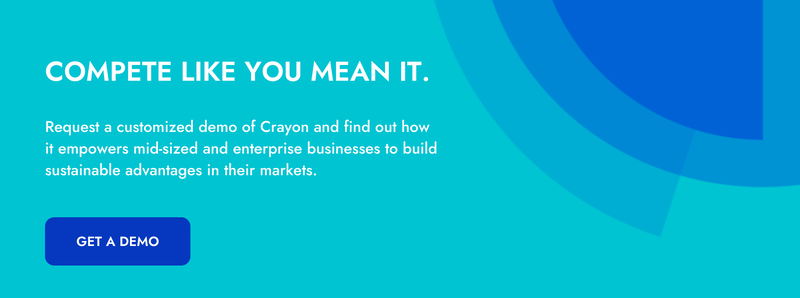This is a Crayon guest post from one of our partners, PSP Enterprises. Visit the Crayon Partner Directory to learn more!
The hypercompetitive New York Yankees owner George Steinbrenner said it best: “Winning is the most important thing in my life, after breathing. Breathing first, winning next.”
In business as in baseball, it pays to keep your eye on the ball. Win/loss interviews uncover how and why customers make their competitive decisions so you can win more deals in the future.
Whether you conduct win/loss interviews in-house or outsource them to an agency, here are ten best practices that can help you up your game.
1. Choose the right deals to interview.
You want to interview opportunities where you competed to the bitter end — no early qual-outs, renewals, or other deals where respondents can’t compare you in detail with alternatives. Generally, larger transactions are more consequential, but don’t rule out small deals that represent footholds in strategic accounts.
Use your CRM system to identify candidate opportunities and then validate your selections with sales. Don’t simply ask sales to “nominate” deals for interviews or they may cherry-pick deals and bias results.
Additionally, you’ll want to interview both wins and losses for a balanced view. Focus win interviews on the kinds of deals you most often lose or where you have beaten your toughest competitors. These will be your best source of insight into how to overcome the weaknesses highlighted in your losses.
Whether they refute competitive FUD or demonstrate solutions to legitimate customer concerns, the winning strategies you discover and the customer quotes that prove they work are like gold for your sales training and management presentations.
2. Interview customers, not just reps.
Don’t rely on sales reps to tell you why they won or lost. Sales reps are not mind readers! To find out what was in the mind of the customer, you need to interview the customer. You should still survey reps, but ask them questions they can answer:
- Which competitors were they up against?
- Who won?
- What aspects of the campaign went well or not well?
- Were there any surprises?
- Any best practices to share?
- Any feedback for corporate?
These kinds of insights complement what you learn from customers without inviting speculation.
3. Interview the head of the selection committee.
Usually, the best respondent for a win/loss interview is the senior-most person deeply involved in the decision-making process; commonly this person is the head of the selection committee.
As a backup, you could interview a program manager who ran the process. Ultimately, you want a person who can speak to the full scope of the decision, including functional, economic, commercial, and strategic issues at stake. Avoid executives who merely sign off on decisions but can’t speak to them in detail. Likewise, avoid people who can tell you only part of the story.
4. Conduct unscripted, semi-structured interviews.
An interview affords you only 30-60 minutes to uncover all the important factors that led to the buyer’s choice, so a good plan is essential. Since there is a lot to cover, overly scripted interviews are a common pitfall.
We’ve all been on the receiving end of tedious interviews of this type, when respondents give “robotic” interviewers pat answers to try to wind up the interview as quickly as possible. To cover the bases without reading from a script, first identify the buyer’s criteria in the buyer’s own terms, followed up by an assessment of the pros and cons of the vendors considered. The simple question, “Why did you go with X?” kicks off a natural conversation that uncovers the criteria that mattered. You can then ask for importance ratings for these criteria and vendor ratings for each.
Then, you can spend most of your time finding out WHY respondents rate the vendors as they did, starting with the highest importance criteria. This semi-structured interview will not only get your respondent to open up and speak freely but will also systematically identify and prioritize the issues at stake.
5. Conduct blind and anonymous interviews.
No matter how well-intentioned they may be, your customers are only human. So, you have to do what you can to reduce bias in their responses. Blind and anonymous interviews are the most reliable approach — especially helpful when discussing sensitive topics such as sales tactics, pricing, and vendor strategy.
In a blind interview, customers don’t know who commissioned the interview. Anonymous interviewing protects the identity of the respondents so they don’t have to worry that their comments will come back to haunt them.
However, unfortunately, blind interviews are not always possible. If you do win loss in-house, blind interviewing that misrepresents your identity would be unethical. And even if you outsource interviewing, privacy laws may effectively constrain you to non-blind interviewing.
Still, blind or non-blind, anonymous interviewing is always a best practice.
6. Secure sales leadership endorsement.
The success of a win/loss project depends on the cooperation of sales reps: at the very least, you’ll need help to validate competitive deals and identify the right people to interview.
But, before you start to ask salespeople for their help, first have a senior sales leader formally announce the program, emphasize its importance to the sales organization and set out specifically what is expected from the reps.
Without this aircover, you might get help the first time, but when you go back for the second round, you will get very little cooperation. Communications from the top sales executive, repeated at least quarterly, and reinforced through first-line sales management are necessary to make it clear that your work is in support of sales, and that reps are expected to cooperate with you to make the program a success.
7. Give reps the interview transcripts.
Reps are a lot less willing to cooperate in win/loss interviews when they feel that they are being spied on by corporate, so give them a copy of the interview transcript.
It’s natural to feel nervous if there’s a report about you that you never see. Win the reps’ trust by promising and then giving them the transcripts. Plus, they value the feedback
When in doubt, make them anonymous. Anonymous interview transcripts can be shared without fear of embarrassment. Once you get these in rep’s hands, they will see how valuable the program is to THEM and they will become your biggest supporters. Don’t be surprised when they then start to proactively reach out to you with contacts for win and loss interviews because they want the feedback.
8. Do enough interviews to justify action.
At first, you can deliver a lot of value with just a handful of interviews. Those initial transcripts can be eye-opening. Surprisingly, what you believe to be your main strengths and weaknesses can matter less to customers than you expect.
However, just a few interviews won’t be enough for you to credibly lobby management to make significant changes. As a rule of thumb, 16 interviews — 8 wins and 8 losses — is enough to get reasonable confidence using statistical methods such as Student’s T Test.
Just remember to execute the interviews quickly enough that the results are representative of current market conditions. If you take too long, your findings could become dated and irrelevant.
9. Start with one product and sales region.
At the onset of your win/loss program, don’t bite off more than you can chew — especially if you have a diverse customer base and a large global sales organization.
Going global from day one can be a tall order. It’s more efficient to run a 16-interview pilot in one region for the first quarter and expand from there.
If you build up a win/loss program from a realistic number of interviews, you can develop a good reputation with sales, marketing, and product management as being genuinely helpful to their success. This will increase the cooperation you get and make it easier to do more interviews. It usually takes 2-3 quarters to get that going in any given region of the sales force. Certainly, coming into a new region after establishing the program elsewhere makes it MUCH easier.
10. Prioritize actions.
With win/loss as with other things, if everything is important, then nothing is important. You need to prioritize the actions that will really move the needle for the company. If a win/loss program doesn’t change your company’s operations or strategy, it’s simply not worth doing.
The priorities of issues you discover will depend on 1) how impactful the issues are on customer decisions, 2) how many deals are affected, and 3) how valuable deals of that type are to the company’s strategy.
A successful win/loss program with a reliable analytic methodology can answer #1. You’ll need CRM data (possibly with much cleansing) to assess #2. Your findings may well influence the company’s outlook on #3.
Then, in your presentations, couple your quantitative analysis with illustrative customer quotes from your interviews. Especially if gathered through a blind and anonymous interview, nothing will exemplify your findings more powerfully than the words of the customer.

Related Blog Posts
Popular Posts
-
 The 8 Free Market Research Tools and Resources You Need to Know
The 8 Free Market Research Tools and Resources You Need to Know
-
 How to Measure Product Launch Success: 12 KPIs You Should Be Tracking
How to Measure Product Launch Success: 12 KPIs You Should Be Tracking
-
 24 Questions to Consider for Your Next SWOT Analysis
24 Questions to Consider for Your Next SWOT Analysis
-
 How to Create a Competitive Matrix (Step-by-Step Guide With Examples + Free Templates)
How to Create a Competitive Matrix (Step-by-Step Guide With Examples + Free Templates)
-
 6 Competitive Advantage Examples From the Real World
6 Competitive Advantage Examples From the Real World




